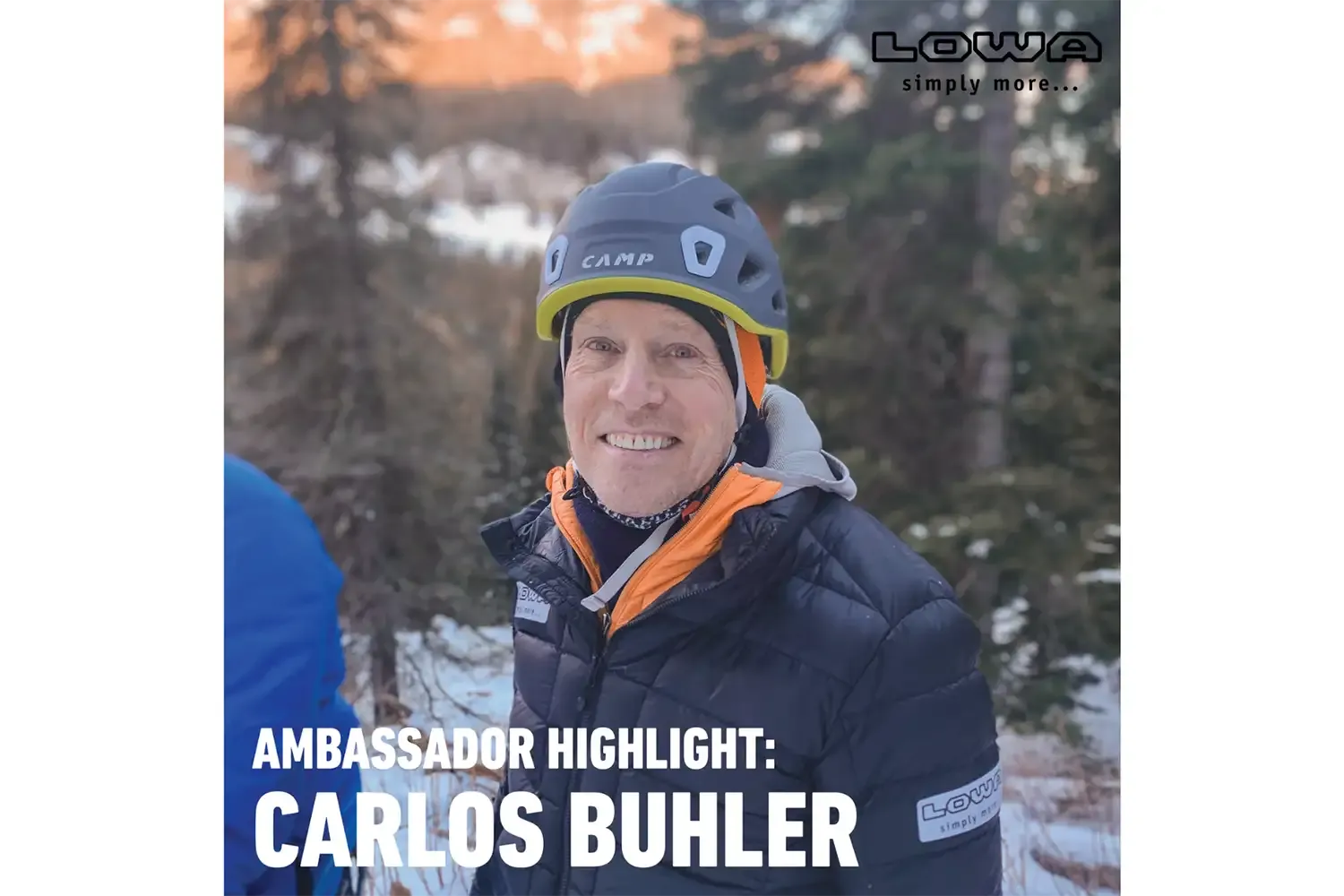Ambassador Highlight: Carlos Buhler

From an excerpt of "LOWA 100 Years, Meet Our Ambassadors"
Meet LOWA Ambassador Carlos Buhler, who during ice festival season leads LOWA-sponsored clinics that have introduced thousands of aspiring climbers to the sport over the last decade. Carlos is also a leadership expert and meeting facilitator, and most recently, is the founder of The Heart of Ukraine, a humanitarian effort that procures much-needed cardiology supplies and funds for Ukrainian hospitals and cardiac units.
"My 35-year career in the unforgiving world of high altitude mountaineering includes ascents of Everest, Changabang, Ama Dablam, Baruntse, Sepu Kangri, Kampur and Milarepa, all by new routes. None of these routes has ever been repeated. I have successfully scaled six of the world’s nine highest peaks, including the world’s three highest, Everest (via the first ascent of the Kangshung Face), K2 (via the North Ridge) and Kangchenjunga (via the North Ridge), becoming the first American to reach this summit.
My experience leading international climbing teams has given me unique perspectives into the delicate challenges of multicultural communication, leadership development and team dynamics. Since 1985 I have presented seminars and facilitated meetings for a wide variety of organizations in which leadership roles are carefully tuned to create an environment that allows teams to excel."

WHAT IS A MOTTO THAT INSPIRES YOU?
“I can only say that putting things off is a mistake and to live every second is so important. Life is unpredictable and not to live it to its fullest is a tragedy.” Carl Dean, a friend of mine, dying of cancer, in a letter to me.
I have carried Carl’s quote in my heart nearly all my adult life. I try to never forget its signifi- cance.
My thoughts on success and tragedy, so intertwined in my mind, and my hope to have some influence to change things; of embracing fate with the hope of influencing it.
“The people who succeed and do not push on to greater failure are the spiritual middle classes. Their stopping at success is proof of their compromising insignificance. How petty their dreams must have been.” Eugene O’Neill, Playwright, in a letter to the critic Arthur Hobson Quinn, on the presence and force of determinism, the meaning of life, and freeing forces of human imagination.
WHAT ADVICE DO YOU HAVE FOR PEOPLE LOOKING TO BREAK INTO YOUR SPORT?
Today’s indoor climbing gyms offer the best and most efficient bang for the buck introduction to climbing, in my opinion. Additionally, they are social hubs for many outdoor climbers. They offer a cheap, efficient means of obtaining education and skill in rope management, climbing and belaying. When teaching out door climbing skills, I have noted that individuals with the basics down, i.e. tying knots, harness use, belaying techniques, communication between belayer and climber, climbing movement and strength, and lead climbing awareness and sequences, are able to concentrate on the more expanded awareness that is required for climbing outside in natural surroundings. Self-propelled wilderness activities, of which climbing is a part, can be learned very efficiently over time by introducing variables and diffi- culty in a controlled, gradual progression. Schools such as the National Outdoor Leadership School do an amazing job of concentrating and delivering a great deal of knowledge in a short time span. However, these schools miss out on the local relationship building that goes along with learning with peers in your gym and neighborhood. A combination of the two may be the best method. Social media plays a big role today in finding introductions and partner- ships where learning outdoor activities is possible. Local clubs are very good places to begin skill acquisition.
The hardest part is taking the first step: reaching out for that first introduction to an activity. My advice is don’t be shy. Everyone feels the same way. I find that people are very open to sharing knowledge and welcoming beginners. Everyone has been through this initial stage!
WHAT DO YOU ALWAYS HAVE IN YOUR PACK?
I don’t mind just being cold. Or just wet. But I don’t like being cold and wet. In my pack I tend to carry that which guards against this possible outcome; thus, a dry, upper inner layer and/or a spare pair or two of gloves or mittens frequently goes into my pack. In addition, I carry a warm layer for a protracted period of inactivity. It’s not light and fast. But it generally gives me a margin of safety. I have a small kit for emergencies which consists of a lighter or two, tape, a very small knife, and absorbent bandage material. I have hardly ever used the bandage material but I still carry it, as much for my party as for others around me. I carry something to drink, but not as much as some. I tend to over-drink on the way to an outing’s trailhead in order to super hydrate my system before I set off. Often, I finish the day with fluid still in my water container.
